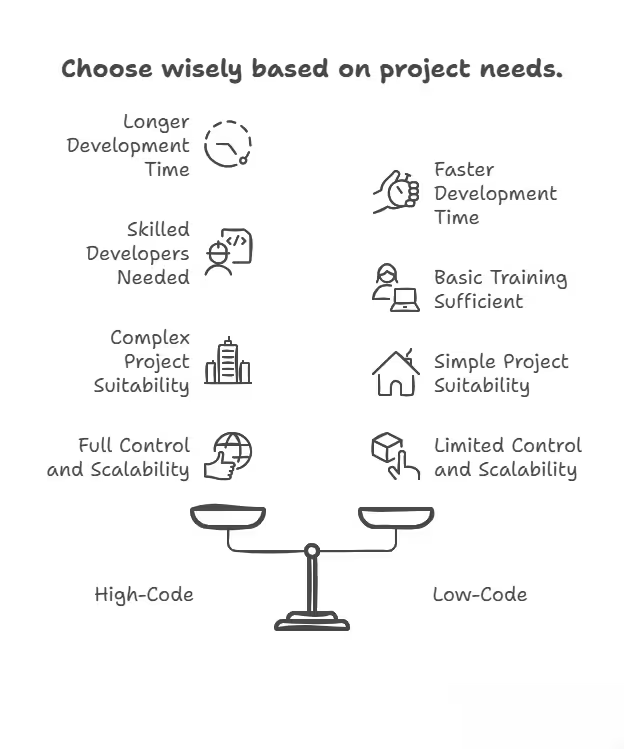High-Code vs Low-Code

High-Code vs Low-Code: Why This Choice Drives Your Success?
High-code gives you total control but takes time and money. Low-code is quick and easy but has limits. Let’s break it down like we’re chatting over coffee, using real US examples, fresh stats, and practical fixes for common headaches.
This guide will help you pick the right path to drive growth and win leads in the competitive US market.
📘 Confused between High-Code and Low-Code?
Download our Side-by-Side Comparison Guide – Understand the real trade-offs in speed, cost, scalability, and control.
👉 [Get the Guide]
What Is High-Code Development?
High-code development means building software from the ground up with languages like Python, Java, or C++. It’s like crafting a custom-built car, you design every part to fit your needs.
I’ve led projects building fintech platforms this way, and it’s ideal when you need something unique and powerful. It gives you full control over every detail, but it requires skilled developers and patience.
- What It Does: Developers write, test, and refine every line of code to create tailored solutions. This ensures the software matches your exact requirements, from user interface to backend logic.
- Best For: Complex apps like trading platforms, custom CRMs, or AI-driven systems. Think of a bank needing a secure transaction engine.
- Challenges: Projects often take 6-18 months and cost $100K-$1M+ for enterprise apps. Finding top developers in the US can also be tough.
- Stat: 68% of US firms say high-code projects run 20-30% over schedule due to complexity (Gartner, 2024). Delays often stem from extensive testing and debugging.
- Example: A Texas hospital built a high-code patient portal to integrate with 15-year-old EHR systems. It ensured HIPAA compliance and custom workflows, improving patient satisfaction by 25%.
What Is Low-Code Development?
Low-code is like assembling a car with pre-built parts using drag-and-drop tools. It lets developers and non-tech business users, your “citizen developers”, create apps fast without deep coding skills.
I’ve seen marketing teams launch customer apps in weeks, but it’s not always flexible for complex needs. It’s a game-changer for speed and cost, especially for smaller projects.
- What It Does: Visual platforms with pre-built templates let you build apps with minimal coding. This empowers teams to create solutions quickly, even without advanced technical skills.
- Best For: Workflow tools, customer-facing apps, or rapid prototypes, like a retail loyalty program. It’s great for automating repetitive tasks.
- Challenges: Struggles with unique features or heavy scaling. You might hit a wall if your app needs custom logic.
- Stat: 59% of US companies deliver low-code apps 2-3x faster than high-code, cutting timelines by up to 90% (Forrester, 2024). This speed drives quick wins for businesses.
- Example: A Chicago retailer used low-code to launch a loyalty app in 6 weeks. It slashed development costs by 40% compared to high-code, boosting customer retention by 15%.
🧩 Which approach is right for your next product?
Take our 2-minute quiz to get a personalized Low-Code vs High-Code Fit Report for your project.
👉 [Take the Assessment]
Challenges in High Code vs Low Code Development
I’ve dug through Reddit, Stack Overflow, and my own project logs to find the biggest pain points US businesses face with high-code and low-code.
Here’s what’s tripping people up and how to fix it, based on real experiences and data.
Breaking Through Customization Barriers
What’s the problem? Low-code platforms often can’t handle unique business needs, like custom workflows or niche features. I’ve seen teams stall when their app required logic the platform couldn’t support. High-code, on the other hand, lets you build anything but takes longer.
- Low-Code Issue: 65% of US low-code users need custom code for special features, negating some speed benefits (Stack Overflow, 2024). This often happens in industries like logistics or healthcare.
- High-Code Strength: Offers total flexibility for bespoke solutions, like a custom CRM I built for a logistics firm that handled unique routing algorithms.
- How to Fix: Use low-code for standard features (like forms or dashboards) and high-code for unique logic. This hybrid approach saves time while meeting specific needs.
- Example: A New York e-commerce startup used low-code for its storefront but switched to high-code for a custom AI recommendation engine. The result? Sales jumped by 15% due to personalized suggestions.
Solving Legacy System Integration
Why is it tough?
Connecting low-code apps to old databases or APIs is a headache, especially in US industries like banking, healthcare, or manufacturing, where legacy systems are common.
High-code makes integration easier but requires expertise.
- Low-Code Problem: 70% of US firms struggle to integrate low-code with legacy systems, like mainframes or old ERPs (Reddit, 2025). This slows down projects significantly.
- High-Code Strength: Easily links to any system. I integrated a banking app with 20-year-old mainframes, ensuring seamless data flow.
- How to Fix: Use middleware (like MuleSoft) or APIs to bridge low-code to legacy systems. Plan integration early to avoid surprises.
- Example: A Florida insurer used middleware to connect a low-code claims app to its 20-year-old database. This saved 30% on integration costs and sped up claims processing by 20%.
Escaping Vendor Lock-In Traps
What’s the risk?
Low-code platforms can lock you into their ecosystem, making it hard and costly to switch vendors. I’ve seen companies pay big to migrate their apps. High-code avoids this by giving you full ownership of your code.
- Low-Code Problem: 60% of US firms face migration challenges with low-code platforms due to proprietary formats (Forrester, 2024). This can cost $50K-$200K to resolve.
- High-Code Strength: You own the code, so you’re free to move to any platform or cloud, like an app I built that was ported across AWS and Azure with no issues.
- How to Fix: Choose low-code platforms with open APIs or exportable code, like Appsmith or Mendix. Always check the exit strategy before committing.
- Example: A US SaaS startup picked a low-code platform with JSON exports, saving $50K when switching vendors without rebuilding their app.
Leveraging AI in Low-Code
AI is transforming low-code platforms in 2025, making them smarter and faster. I’ve seen AI-driven tools cut development time dramatically.
- What It Does: AI generates code, automates testing, and suggests workflows, like auto-building forms or chatbots. It’s like having a virtual developer on your team.
- Impact: Low-code with AI cuts development time by 90% compared to traditional coding, boosting efficiency (Gartner, 2024).
- How to Fix: Choose AI-powered platforms like Niral AI or Mendix to stay ahead. Test AI features to ensure they meet your needs.
- Example: A Seattle startup used an AI-powered low-code tool to build a customer support chatbot in 3 days, saving $20K and improving response times by 40%.
When to Go with High-Code
High-code is your best bet when you need total control and top performance.
- Best For: Complex apps like financial systems, custom AI tools, or enterprise-grade platforms. Think of a bank needing a secure payment gateway.
- What You Need: Skilled developers ($120K-$200K/year in the US) and 6-18 month timelines. Budgets often start at $100K for enterprise projects.
- Why It Wins: Full control over security, compliance, and scalability. You can optimize every detail for performance.
- Stat: 78% of US mission-critical apps use high-code for its flexibility (Forrester, 2024).
- Example: A US logistics company built a high-code supply chain app to optimize routes, cutting delivery times by 20% and saving $500K annually.
When to Pick Low-Code
Low-code shines when you need speed and ease.
- Best For: Business automation, customer apps, or prototypes, like HR workflows or e-commerce dashboards. It’s perfect for quick wins.
- What You Need: Business users with basic training (2-4 weeks) and platform licenses ($10K-$100K/year). Projects can launch in 2-8 weeks.
- Challenges: Watch for governance and integration issues. Plan ahead to avoid surprises.
- Stat: 63% of US low-code projects cut delivery time by 50%, boosting agility (Gartner, 2024).
- Example: A Miami healthcare startup built a low-code scheduling app in 4 weeks, saving $75K and reducing appointment no-shows by 30%.

Why a Hybrid Approach Wins Big
A hybrid approach mixes low-code speed with high-code power, giving you the best of both worlds.
- How It Works: Use low-code for front-end apps (like customer portals) and high-code for back-end systems (like secure APIs). This balances speed and flexibility.
- Why It Wins: Saves time and money while meeting complex needs. It’s perfect for businesses with diverse requirements.
- Stat: 52% of US companies use hybrid models to optimize development (Reddit, 2025).
- Example: A Denver retailer used low-code for a customer app and high-code for inventory APIs, launching in 3 months with 30% cost savings and a 10% sales boost.
How to Choose the Right Path for Your US Business
Picking between high-code and low-code depends on your goals, budget, and team. Need a custom app with top performance?
Go high-code. Want to move fast and involve your business team?
Try low-code. A hybrid approach often gives you speed and control.
Here’s how to decide:
- Assess Your Needs: Is your project simple (like a workflow tool) or complex (like a trading platform)? Do you need speed or precision?
- Test Platforms: Try low-code tools like Niral AI, Appsmith, or Bubble to see if they fit. Check high-code frameworks like Django or Spring.
- Train Your Team: Upskill business users for low-code and hire strategically for high-code. Use platforms like Coursera for training.
- Plan for Growth: Ensure your choice scales with your business, especially for high-traffic apps.
- Stat: 98% of US enterprises use low-code for some projects, with 91% citing agility as the top benefit (Mendix, 2025).
- Example: A US manufacturing firm I advised used low-code for internal dashboards and high-code for IoT integrations, cutting costs by 25% and improving efficiency by 15%.
Ready to transform your business? Contact our team for expert advice on your digital journey.
We’ve helped US companies save millions and launch faster, let’s do the same for you.


